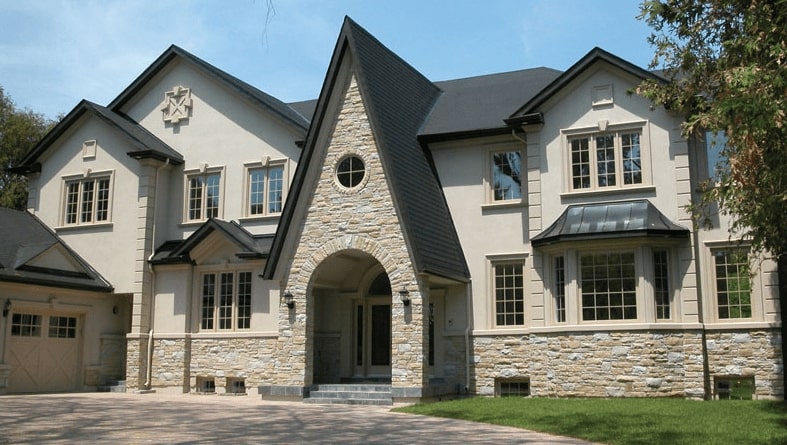April 10, 2024 / By alasyaconstruction

Stone veneer serves as a remarkable siding option, crafted from either natural stone slices or manufactured stone pieces, meticulously designed to replicate the appearance of solid stone construction. This versatile material not only enhances the aesthetic appeal of both exterior and interior spaces but also offers flexibility in installation, adaptable to various surfaces.
Embarking on the journey of installing stone veneer requires meticulous attention to detail and adherence to a systematic process. Below, you’ll discover a comprehensive step-by-step guide, meticulously crafted to ensure a seamless installation process.
Areas You Can Install Veneer
Stone veneer offers remarkable versatility, lending its timeless charm to various areas within both interior and exterior spaces. Its adaptability extends to:
**1. Fireplaces:** Stone veneer is a transformative option for enhancing the allure of any fireplace, whether it’s a traditional wood-burning hearth, a gas fireplace, or a sleek electric unit. The rugged elegance of stone creates a striking focal point, infusing warmth and character into the ambiance.
**2. Interior Walls:** Elevate the aesthetics of interior walls with the rich textures and earthy tones of stone veneer. Whether applied to drywall, sheetrock, plywood, or fiber cement surfaces, stone veneer adds depth and visual interest to living spaces, kitchens, bathrooms, or feature walls, fostering a sense of rustic elegance or contemporary sophistication.
**3. Exterior Walls:** Extend the charm of your home’s facade with the enduring beauty of stone veneer. From enhancing curb appeal to adding architectural interest, veneer stone effortlessly transforms exterior walls, creating a lasting impression. Its durability and weather resistance make it an ideal choice for accentuating entryways, facades, or entire exterior surfaces.
**4. Columns:** Infuse elegance and dimension into columns with the addition of stone veneer. Whether gracing the porch, entryway, or interior spaces, stone-clad columns exude timeless sophistication and curb appeal. The versatility of stone veneer allows for seamless integration with various architectural styles, from classical to contemporary.
**5. Accent Features:** Beyond traditional applications, stone veneer lends itself to a myriad of accent features, including kitchen islands, backsplashes, accent walls, and built-in shelving. Its versatility enables homeowners to imbue their spaces with personalized charm and style, enhancing both functionality and visual appeal.
**6. Landscaping Elements:** Enhance outdoor living spaces with the natural beauty of stone veneer. From creating captivating retaining walls and garden borders to embellishing outdoor kitchens, fire pits, and water features, stone veneer adds a touch of rustic elegance to landscaping designs, seamlessly blending with the surrounding environment.
**7. Architectural Details:** Elevate architectural details such as archways, alcoves, and niches with the intricate textures and organic allure of stone veneer. Whether used to frame doorways, accentuate windows, or embellish structural elements, stone veneer lends a timeless charm and refinement to architectural features, enhancing the overall aesthetic appeal of the space.
Incorporating stone veneer into these diverse areas not only adds visual interest and sophistication but also imbues spaces with a sense of warmth, character, and enduring beauty. With its versatility and timeless appeal, stone veneer stands as a testament to the harmonious fusion of nature-inspired design and modern innovation, enriching both interior and exterior environments alike.
Equipment required to install stone veneer
For a smooth and efficient installation of stone veneer, it’s essential to have the right tools and materials at your disposal. Here’s a list of what you’ll need:
1. **Masonry Trowel:** Used to spread the bond coat mortar and scratch the surface for better adhesion.
2. **Mason Hammer or Cut-off Angle Grinder:** Essential for cutting or shaping the stone veneer pieces to fit the desired layout.
3. **Rake:** Helps in creating a scratch coat on the surface for improved mortar adhesion.
4. **Staple Gun or Nail Gun:** Used to secure the metal lath to the surface before applying the stone veneer.
5. **Grout:** Required to fill the spaces between the stone joints after placement, ensuring a seamless finish.
6. **Joint Tool:** Used for smoothing and finishing the grout joints for a polished appearance.
7. **Brushes:** One brush is needed to dampen the veneer stones for better adhesion, while another is used to dust and clean the stones once the installation is complete.
8. **Moisture Barrier:** Essential for exterior installations to protect against moisture infiltration and ensure long-term durability.
9. **Galvanized Metal Lath:** Provides a stable surface for the stone veneer and enhances mortar adhesion.
10. **Galvanized Nails or Staples:** Used to secure the metal lath to the surface before applying the stone veneer.
11. **Stone Veneer Mortar:** Specially formulated mortar designed for adhering stone veneer to various surfaces, ensuring a strong and durable bond.
Having these tools and materials on hand will streamline the installation process and ensure a successful outcome, whether you’re working on interior walls, exterior facades, fireplaces, or other applications.
Things to consider before installing stone veneer
Before embarking on the installation of stone veneer, several crucial considerations must be taken into account to ensure a successful and visually appealing outcome:
**1. Aesthetics:** Begin by envisioning the desired appearance of the finished project. Consider factors such as stone size, shape, color, and layout to achieve the desired aesthetic effect. Whether aiming for a rustic, traditional look or a more contemporary vibe, your aesthetic preferences will guide the selection of stone veneer options.
**2. Stone Type:** Decide whether to utilize natural stone veneer or manufactured stone. Natural stone offers authentic beauty with unique variations, while manufactured stone provides consistency in size, shape, and color, along with cost-effectiveness. Select the option that best suits your aesthetic vision, budget, and project requirements.
**3. Measurements:** Accurate measurements are essential for determining the quantity of stone veneer required. Calculate the surface area to be covered by multiplying the width by the height. Subtract the surface area occupied by windows, doors, corners, or other structural elements to obtain the total square footage. This calculation ensures that you purchase the appropriate amount of stone veneer, minimizing waste and potential delays.
**4. Mortar Joint Size:** Consider the desired mortar joint size, which refers to the space between the individual pieces of stone. Standard mortar joint sizes are typically around ½ inch. However, if you prefer a different joint size for aesthetic or structural reasons, adjustments to your calculations will be necessary. Ensure consistency in mortar joint size throughout the installation process to achieve a cohesive and visually pleasing result.
By carefully considering these key factors before initiating the installation process, you can lay the foundation for a seamless and successful stone veneer project that fulfills your aesthetic vision while meeting practical requirements.
HOW TO INSTALL STONE VENEER
Below are the detailed steps to follow when installing stone veneer:
**1. Prepare the Surface:**
– For framed exterior walls, begin by applying a moisture barrier. Cover the surface with waterproof building paper, ensuring horizontal overlap of at least 6 inches between sheets. Securely fasten a metal lath sheet using galvanized nails, spacing them a maximum of 6 inches apart vertically and 16 inches apart horizontally. Nails should penetrate the studs at least 1 inch.
– For framed interior walls, install the metal lath using galvanized screws or nails, spacing them 6 inches apart vertically and 16 inches apart horizontally. Ensure the fasteners penetrate the studs at least 1 inch.
– Concrete exterior or interior walls typically do not require metal lath. Ensure the surface is clean and free of debris. If painted, sandblast or scrape off the paint.
**2. Mix and Apply a Scratch Coat:**
– If using metal lath, prepare a scratch coat by mixing 1 part masonry cement with 2½ parts sand. Gradually add water and mix until a paste-like consistency is achieved. Apply the scratch coat evenly over the metal lath, ensuring a thickness of about ½ inch and filling in any holes.
– Use a rake to create long horizontal lines on the scratch coat while it is still somewhat wet. Allow the scratch coat to dry and set for 24 to 36 hours.
**3. Install the Veneer Stone:**
– Arrange the stone veneer pieces on the ground to mirror the desired pattern for the finished look.
– Trim and cut stones as needed using an angle grinder or mason hammer, shaping and smoothing edges as necessary.
– Clean stones of dirt, dust, or oil using a brush. If necessary, wash stones and allow them to dry before use.
– Prepare mortar for the bond coat, ensuring it has the same consistency as the scratch coat.
– Dampen the back of each stone with a masonry brush to prevent it from absorbing water from the mortar.
– Apply mortar to the back of each stone using a masonry trowel, ensuring an even layer approximately ½ inch thick.
– Begin hanging the veneer stones in a bottom-up direction, starting with corners. Press stones firmly onto the scratch coat, allowing some mortar to squeeze out. Tilt or rotate each stone slightly to remove excess air.
– Maintain consistent spacing between stones and ensure joints are uniform.
– Fill joint spaces between stones with grout, ensuring a thickness of approximately ½ inch. As the grout stiffens, use a joint tool to remove excess mortar. Use a broom to smooth and clean away loose mortar from the stone surface.
By meticulously following these steps, you can achieve a professional and durable installation of stone veneer that enhances the aesthetic appeal of any surface.
In need of professional stone veneer installation services? Look no further than Alasya Construction. Our team of skilled craftsmen specializes in delivering meticulous and high-quality installations, ensuring your vision becomes a reality. With a commitment to excellence and attention to detail, we guarantee a stunning transformation for your home or commercial space. Contact Alasya Construction today to bring the timeless beauty of stone veneer to your project. Your dream design awaits!




